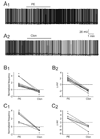Activation of alpha1 and alpha2 noradrenergic receptors exert opposing effects on excitability of main olfactory bulb granule cells
- PMID: 20466037
- PMCID: PMC2904409
- DOI: 10.1016/j.neuroscience.2010.05.010
Activation of alpha1 and alpha2 noradrenergic receptors exert opposing effects on excitability of main olfactory bulb granule cells
Abstract
The mammalian main olfactory bulb (MOB) receives a dense noradrenergic innervation from the pontine nucleus locus coeruleus that is important for neonatal odor preference learning and odor processing in mature animals. Modulation of GABAergic granule cells (GCs) is thought to play a key role in the net functional impact of norepinephrine (NE) release in the MOB, yet there are few direct studies of the influence of NE on these cells. In the present study we investigated noradrenergic modulation of GC excitability using electrophysiological approaches in rat MOB slices. A moderate concentration of NE (10 microM) and the alpha1 receptor agonist phenylephrine (10 microM) depolarized and increased spontaneous or current injection-evoked spiking in GCs. By contrast, low NE concentrations (0.1-1.0 microM) or the alpha2 receptor agonist clonidine (Clon, 10 microM) hyperpolarized and decreased the discharge of GCs. The effects of NE (10 microM) were blocked by antagonism of alpha1 and alpha2 receptors. Inhibitory effects of low NE concentrations were blocked or converted to excitatory responses by alpha2 receptor blockade, whereas excitatory effects of the moderate NE concentration were converted to inhibitory responses after alpha1 receptor blockade. NE (10 microM) and phenylephrine elicited inward currents that reversed near the potassium equilibrium potential. The effects of NE and phenylephrine were associated with increased membrane input resistance. Clonidine elicited an outward current associated with decreased membrane input resistance that reversed near the potassium equilibrium potential. These results indicate that alpha1 and alpha2 receptor activation exert opposing effects on GC excitability. Low concentrations of NE acting via alpha2 receptors suppress GC excitability, while higher concentrations of NE acting at alpha1 receptors increase GC excitability. These findings are consistent with recent findings that alpha1 and alpha2 receptor activation increase and decrease, respectively, GABAergic inhibition of mitral cells. The differential affinities of alpha1 and alpha2 noradrenergic receptor subtypes may allow for differential modulation of GABA release and olfactory processing as a function of the level of NE release, which in turn, is regulated by behavioral state.
Copyright (c) 2010 IBRO. Published by Elsevier Ltd. All rights reserved.
Figures





Similar articles
-
Direct excitation of mitral cells via activation of alpha1-noradrenergic receptors in rat olfactory bulb slices.J Neurophysiol. 2001 Nov;86(5):2173-82. doi: 10.1152/jn.2001.86.5.2173. J Neurophysiol. 2001. PMID: 11698509
-
Noradrenergic regulation of GABAergic inhibition of main olfactory bulb mitral cells varies as a function of concentration and receptor subtype.J Neurophysiol. 2009 May;101(5):2472-84. doi: 10.1152/jn.91187.2008. Epub 2009 Mar 11. J Neurophysiol. 2009. PMID: 19279145 Free PMC article.
-
Norepinephrine increases rat mitral cell excitatory responses to weak olfactory nerve input via alpha-1 receptors in vitro.Neuroscience. 1999 May;90(2):595-606. doi: 10.1016/s0306-4522(98)00437-0. Neuroscience. 1999. PMID: 10215162
-
Noradrenergic modulation of behavioral odor detection and discrimination thresholds in the olfactory bulb.Eur J Neurosci. 2010 Aug;32(3):458-68. doi: 10.1111/j.1460-9568.2010.07297.x. Epub 2010 Jul 5. Eur J Neurosci. 2010. PMID: 20618829
-
Noradrenergic targets for the treatment of alcohol use disorder.Psychopharmacology (Berl). 2018 Jun;235(6):1625-1634. doi: 10.1007/s00213-018-4843-6. Epub 2018 Feb 20. Psychopharmacology (Berl). 2018. PMID: 29460163 Free PMC article. Review.
Cited by
-
Norepinephrine Modulates Pyramidal Cell Synaptic Properties in the Anterior Piriform Cortex of Mice: Age-Dependent Effects of β-adrenoceptors.Front Cell Neurosci. 2015 Nov 19;9:450. doi: 10.3389/fncel.2015.00450. eCollection 2015. Front Cell Neurosci. 2015. PMID: 26635530 Free PMC article.
-
The interaction of octopamine and neuropeptides to slow aversive responses in C. elegans mimics the modulation of chronic pain in mammals.Worm. 2012 Oct 1;1(4):202-6. doi: 10.4161/worm.20467. Worm. 2012. PMID: 24058849 Free PMC article.
-
Distinct roles of bulbar muscarinic and nicotinic receptors in olfactory discrimination learning.J Neurosci. 2014 Aug 20;34(34):11244-60. doi: 10.1523/JNEUROSCI.1499-14.2014. J Neurosci. 2014. PMID: 25143606 Free PMC article.
-
A Population of Interneurons Signals Changes in the Basal Concentration of Serotonin and Mediates Gain Control in the Drosophila Antennal Lobe.Curr Biol. 2020 Mar 23;30(6):1110-1118.e4. doi: 10.1016/j.cub.2020.01.018. Epub 2020 Mar 5. Curr Biol. 2020. PMID: 32142699 Free PMC article.
-
Noradrenergic inputs from the locus coeruleus to anterior piriform cortex and the olfactory bulb modulate olfactory outputs.Nat Commun. 2025 Jan 2;16(1):260. doi: 10.1038/s41467-024-55609-9. Nat Commun. 2025. PMID: 39747920 Free PMC article.
References
-
- Berridge C, Waterhouse B. The locus coeruleus-noradrenergic system: modulation of behavioral state and state-dependent cognitive processes. Brain Res Rev. 2003;42:33–84. - PubMed
-
- Czesnik D, Nezlin L, Rabba J, Muller B, Schild D. Noradrenergic modulation of calcium currents and synaptic transmission in the olfactory bulb of Xenopus laevis. Eur J Neursci. 2001;13:1093–1100. - PubMed
Publication types
MeSH terms
Substances
Grants and funding
LinkOut - more resources
Full Text Sources
Miscellaneous

